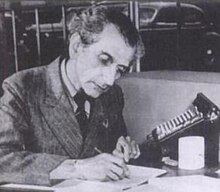
Back كورنيليوس لانكزوس ARZ Cornelius Lanczos Catalan Cornelius Lanczos German Kornél Lánczos Esperanto Cornelius Lanczos Spanish Cornelius Lanczos French קורנל לאנצוש HE Lánczos Kornél Hungarian Cornelius Lanczos Italian コルネリウス・ランチョス Japanese
Cornelius Lanczos | |
|---|---|
 | |
| Born | February 2, 1893 |
| Died | June 25, 1974 (aged 81) |
| Nationality | Hungarian |
| Alma mater | University of Budapest University of Szeged |
| Known for | Lanczos algorithm Lanczos tensor Lanczos resampling Lanczos approximation Lanczos sigma factor Lanczos differentiator Lanczos–van Stockum dust |
| Spouse(s) | Mária Erzsébet Rump (1928–1939) Ilse Hildebrand (1954–1974) |
| Awards | Chauvenet Prize (1960)[1] |
| Scientific career | |
| Fields | Mathematics Theoretical physics |
| Institutions | University of Freiburg Purdue University Boeing Institute of Numerical Analysis Dublin Institute for Advanced Studies Frankfurt University |
| Thesis | Relation of Maxwell's Aether Equations to Functional Theory (1921) |
| Doctoral advisor | Rudolf Ortvay |
| Other academic advisors | Loránd Eötvös Lipót Fejér, Erwin Madelung |
Cornelius (Cornel) Lanczos (Hungarian: Lánczos Kornél, pronounced [ˈlaːnt͡soʃ ˈkorneːl]; born as Kornél Lőwy, until 1906: Löwy (Lőwy) Kornél; February 2, 1893 – June 25, 1974) was a Hungarian-Jewish, Hungarian-American and later Hungarian-Irish mathematician and physicist. According to György Marx he was one of The Martians.[2]
- ^ Lanczos, Cornelius (1958). "Linear Systems in Self-Adjoint Form". Amer. Math. Monthly. 65 (9): 665–679. doi:10.2307/2308707. JSTOR 2308707.
- ^ A marslakók legendája Archived 2022-04-09 at the Wayback Machine – György Marx.